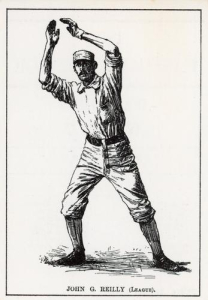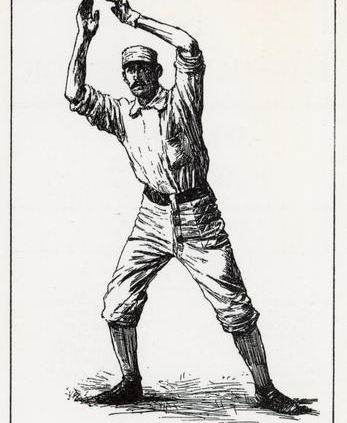September 19, 1883: John Reilly hits for second cycle in five games to back Will White’s 40th win
 The Cincinnati Red Stockings’ bid for a repeat American Association title in 1883 was an uphill battle after the opening month of May. The Red Stockings won 12 of 20 games that month. Unfortunately for the Red Stockings, the Philadelphia Athletics won 18 of their first 21 games, giving them a 5½-game lead at the end of the month.
The Cincinnati Red Stockings’ bid for a repeat American Association title in 1883 was an uphill battle after the opening month of May. The Red Stockings won 12 of 20 games that month. Unfortunately for the Red Stockings, the Philadelphia Athletics won 18 of their first 21 games, giving them a 5½-game lead at the end of the month.
For the next four months, the two teams matched each other’s records, almost month-by-month. Cincinnati won 10 games in June, 14 in July, 13 in August, and 12 in September, while the A’s won 9 games in June, 13 in July, 14 in August, and 12 in September. After May, the Red Stockings were 49-29, compared with the Athletics’ 48-29. No matter how well (or poorly) Cincinnati played, it did not gain (or lose) any ground in the standings against Philadelphia.
In the meantime, a third club, the St. Louis Browns, burned even brighter after the season’s first month, winning 45 of 61 games from June 2 through September 3 to pass the Red Stockings and briefly seize first place from the Athletics.
When Cincinnati and Philadelphia opened a three-game series at the Red Stockings’ Bank Street Grounds on September 15, the Athletics had won seven in a row to wrest first back from the Browns. The Athletics held a 3½-game edge over St. Louis; the advantage was 7½ games over the Red Stockings.
Cincinnati had some momentum, having just won four in a row against the Pittsburgh Alleghenys. First baseman John Reilly had clubbed two home runs against the Alleghenys on September 10, then racked up six hits, completing a cycle, two days later.
The Red Stockings had beaten the A’s in seven of 11 games played so far in 1883, and the two teams split the first two games of this series. Cincinnati’s Will White, who started 65 of the Red Stockings’ 98 games in 1883, pitched a shutout in the first contest for his majors-best 39th win of the season, and his team won easily, 11-0. On September 18 Philadelphia won in 10 innings, 13-12, even though Reilly scored three runs.
A crowd of 1,500 came out to witness the final game of the series, on September 19. The fans were treated to an offensive slugfest by the Red Stockings, led by Reilly, who hit for the cycle for the second time in five games.
White, who had taken the loss in the second game of the series, again sought his 40th win in the finale.1 Opposing him was a veteran right-hander for Philadelphia, George Washington Bradley. Bradley was in his eighth season as a major leaguer, pitching for his seventh different club and in his third different league. He began the season with the National League’s Cleveland Blues but was sold in June to the Athletics after appearing in four games, all at shortstop.2 He had already won 15 games for Philadelphia as the A’s primary backup pitcher to Bobby Mathews, while playing third base when not pitching.3
The home team batted first. With one out in the top of the first, Reilly tripled to left field and scored on a wild pitch, giving the Red Stockings a quick 1-0 lead.
White blanked the Athletics in the first two innings, and in the top of the third, Cincinnati struck again. Chick Fulmer reached on an error by the second baseman, Cub Stricker. White singled to right, and both he and Fulmer scored on Hick Carpenter’s home run, a “terrific drive to left center.”4
According to the Cincinnati Enquirer, a frustrated Bradley then tried to hit Charley Jones with a pitch but missed. He did, however, hit Joe Sommer, and then game was delayed, to “allow Joe to have his arm pulled back into shape.”5 Both runners were left stranded as Bradley worked his way out of the inning.
In the bottom of the third, Philadelphia responded. Bob Blakiston led off with a base on balls. Bradley helped his own cause by rapping a two-run home run to right-center field, cutting the deficit to 4-2. This was his only home run of the season and third of his career.6 Jud Birchall singled but was thrown out trying to steal second base, and White retired the side without any further damage.
There was no action until the fifth inning, when White and Reilly each singled, but they did not score. Bid McPhee tripled with two outs in the sixth and was left there. Stricker led off the bottom of the sixth with a single, just the third hit off White. Birchall lined a pitch toward right field, but second baseman McPhee made a sensational catch and then threw to first, in time to double up Stricker and preserve the Red Stockings’ two-run advantage.
In the top of the seventh, Carpenter singled with one out. Reilly then “made a dandy, shooting the ball clear to the carriages in center field”7 for a home run. Cincinnati now led 6-2.
Philadelphia scratched out a run in the bottom of the eighth, when Bradley singled, advanced to third on a wild throw by Cincinnati catcher Pop Snyder, and scored on a wild pitch by White. The Philly pitcher had accounted for all three of his team’s runs.
Leading 6-3, Cincinnati put the game away, “as the fun culminated in the ninth.”8 White and Carpenter hit back-to-back singles. Reilly, who already had a single, triple, and homer in the game, drove Bradley’s offering into left field for a double, plating White. Carpenter stopped at third base.
Jones lined the ball into the same section of left field for a three-bagger, as Carpenter and Reilly scored. An out later, Pop Corkhill doubled home Jones. Snyder singled and stole second base, and he and Jones crossed home plate on McPhee’s single past the mound. The Red Stockings sent 10 batters up to the plate, making seven hits and scoring six runs. The home team’s batters had banged out 17 hits in the game. Every player except Sommer contributed at least one hit.
White allowed a walk in the bottom of the ninth but retired the Athletics without allowing any threat to build. He was again in top form as he earned his 40th victory of the season. No other pitcher in the AA or NL won more than 36 games in 1883.
Sporting Life reported that the Red Stockings right-hander “had the Athletics at his will.”9 He allowed the opponents just five hits, and he limited all of those safeties to three innings. Further, he “took a hand in the batting business,”10 contributing three hits and two runs scored to the Cincinnati offense.
The Red Stockings took the game and series and then won four of their final six games of the season, but they could not catch the Athletics. Philadelphia managed only three wins in its last seven games, but this was good enough to hold off the Browns by a single game. The Red Stockings were third, five games back. It was the Athletics’ lone pennant during their nine seasons in the American Association.
In addition to his four hits in five at-bats, Reilly scored three runs. Reilly had duplicated his batting feat from a week earlier, when he hit for the cycle against the Alleghenys on September 12. In that game, he had gone 6-for-7 and scored six runs.
By September 1883, there had been four games in major-league history where a batter had hit a single, double, triple, and home run in the same game, and Reilly owned two of those rare performances. From September 10 through 22, 1883, Reilly made 19 hits in 41 at-bats, and those hits included two doubles, three triples, and four round-trippers.11 Over these two weeks, he batted .463 and posted a .639 slugging percentage. Seven seasons later, on August 6, 1890, Long John Reilly became the first player to hit for the cycle three times in his career.12
Acknowledgments
This article was fact-checked by Stew Thornley and copy-edited by Len Levin.
Sources
In addition to the sources mentioned in the Notes, the author consulted Baseball-Reference.com, MLB.com, Retrosheet.org, and SABR.org. Box scores and play-by-play are not available from either Retrosheet or Baseball-Reference.
Notes
1 White earned the victory in this game and in three of his final four decisions. His 43 victories led the league, as did his six shoutouts and 2.09 earned-run average. His 43 wins tied his season-best mark for victories, set in 1879.
2 According to Baseball-Reference, Bradley was sold for “$340 or $500.”
3 According to Bradley’s SABR biography, “In September [1883], when Mathews was out with arm problems, Bradley and Jumping Jack Jones put together a string of pitching performances that enabled the A’s to win seven in a row on their way to the pennant.” See Brian Engelhardt, “George Bradley,” SABR Biography Project, found online at https://sabr.org/bioproj/person/George-Bradley/. Accessed November 2022, January 2023.
4 “Tramped On,” Cincinnati Enquirer, September 20, 1883: 2.
5 “Tramped On.”
6 Bradley ended his career with three home runs in 567 games.
7 “Tramped On.”
8 “Games Played Wednesday, Sept. 19,” Sporting Life, September 24, 1883: 5.
9 “Games Played Wednesday, Sept. 19.”
10 “Tramped On.”
11 David Ball, “John Reilly,” SABR Biography Project. Found online at https://sabr.org/bioproj/person/john-reilly/. Accessed October 2022.
12 As of the end of the 2022 season, that number has increased to six ballplayers. They are Reilly, Bob Meusel (May 7, 1921, July 3, 1922, and July 26, 1928), Babe Herman (May 18, 1931, July 24, 1931, and September 30, 1933), Adrian Beltre (September 1, 2008, August 24, 2012, and August 3, 2015), Trea Turner (April 25, 2017, July 23, 2019, and June 30, 2021) and Christian Yelich (August 29, 2018, September 17, 2018, and May 11, 2022).
Additional Stats
Cincinnati Red Stockings 12
Philadelphia Athletics 3
Bank Street Grounds
Cincinnati, OH
Corrections? Additions?
If you can help us improve this game story, contact us.


